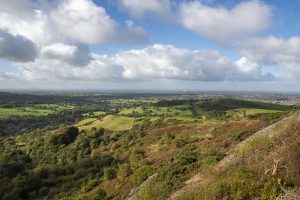
Fiona Reynolds takes a walk in the Cheshire Plain where farming and industry are juxtaposed with startling results.
The Cheshire Plain has always, to me, evoked dairy farming. The flat, vast landscape of the Cheshire Plain is neatly enclosed with hedgerows. It’s also interspersed by tall, handsome red brick farmhouses. This is a reminder of prosperous farming in days gone by. It’s still like that, although dairying has been more precarious in recent years. Those huge farmhouses — and every few miles an elegant hall — still dominate the landscape, but today I’m learning about something else: the farming of brine.
Cheshire Basin (or the Cheshire Plain) is a geological formation that was formed more than 200 million year ago when the Cheshire Plain was buried under the ocean. Huge quantities of sea salt were dumped there. The salt beds became an important resource when the seas receded. From Roman times, towns like Nantwich Middlewich Northwich were named after salt.
In the 19th century, chlorine, manufactured from salt, was the foundation of Britain’s chemical industry. Salt can be mined or surface-extracted and some of Cheshire’s…

